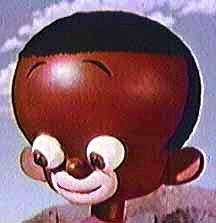
People ask me what I'll be selling in the Theory Corner Store. Well, my own theory booklets, tutorials and comics, for one thing, but I'll also include a lot of stuff that other people are selling. Sometimes I'll get a commission and sometimes not. Sometimes I'll even give away things for free.
Usually what I'm selling will be featured here first, on this blog. The store is a kind of archive for the stuff I'm selling and write about here, only in the store I'll include prices and contact info.
That's what this article is: some of the items here will turn up in the store when it opens. I don't have my seller's permit yet, and in this case I won't make a cent...but it's fun to write about, so I'm happy.

Anyway, the subject is "Making Cartoony Rooms." Here's a nod (above) to the king of cartoony environments, Cliff Sterret."

Anyway, the subject is "Making Cartoony Rooms." Here's a nod (above) to the king of cartoony environments, Cliff Sterret."

Well, to start with, you need a big old comfortable chair, maybe one a little darker than the one above. I don't know how practical these chairs are because they're hell to get through a modern doorway, and they completely dominate a small room. If you could find one that's scaled down a bit, that would be perfect.

Wow! A terrific Cliff Sterret rug (above), just made for cartoon people! I wish I could have gotten a bigger picture of it; it's a thing of beauty! It's round, and about five and a half feet across.

For draperies...never, ever use pull-down shades on a window without draperies...I suggest a zebra skin pattern, or maybe something cartoony and cheery like this Lucy Cousins design. Or maybe a pattern that dupes the Sterret rug. The internet is full of cool fabric designs.

Sterret was fond of mushroom-shaped lamps (above) on high end tables covered with Charlie brown-type cloth. This example is too small and throws all it's light out of the stem, but the better kind are undoubtedly out there somewhere.

On second thought, I think I'd prefer to get my light from a floor lamp in back of the chair. As a side table I prefer a small pillar (even shorter than the one above) with a statue of Napoleon on it.

Or maybe Dega's dancer.

Or maybe the classic discus-thrower. It reminds me of the statue at the base of the stairs in one of the Betty Boop cartoons.

Here's a Napoleon from The Louvre gift shop. It's pricey. There's gotta be a cheaper version.

For artwork, I prefer one of the big, funny Picasso posters (above) (NOT "Guernica"). Don't frame them, but it's okay to mount them on foam board that's the same size as the picture.

I would also put up a framed picture of Whistler's Mother, the Mona Lisa, or the Venus DeMilo. No substitutes. It has to be one or all of these three.
Or maybe one of the marker pictures John K. is selling. Check out his blog!

A tasteful vase or two gives the room a good vibe.
Here's some vases that the Memphis design group used to sell. Very Sterret-like, don't you think?

I deliberately refrained from discussing wallpaper and accessories. Funny wallpaper (like thick, vertical awning stripes) scores high on cartooniness, but it makes the room seem small, and geez, what if you changed your mind later?
About accessories: they can be expensive! That doorknob (above) costs a fortune!






















































